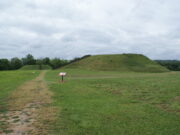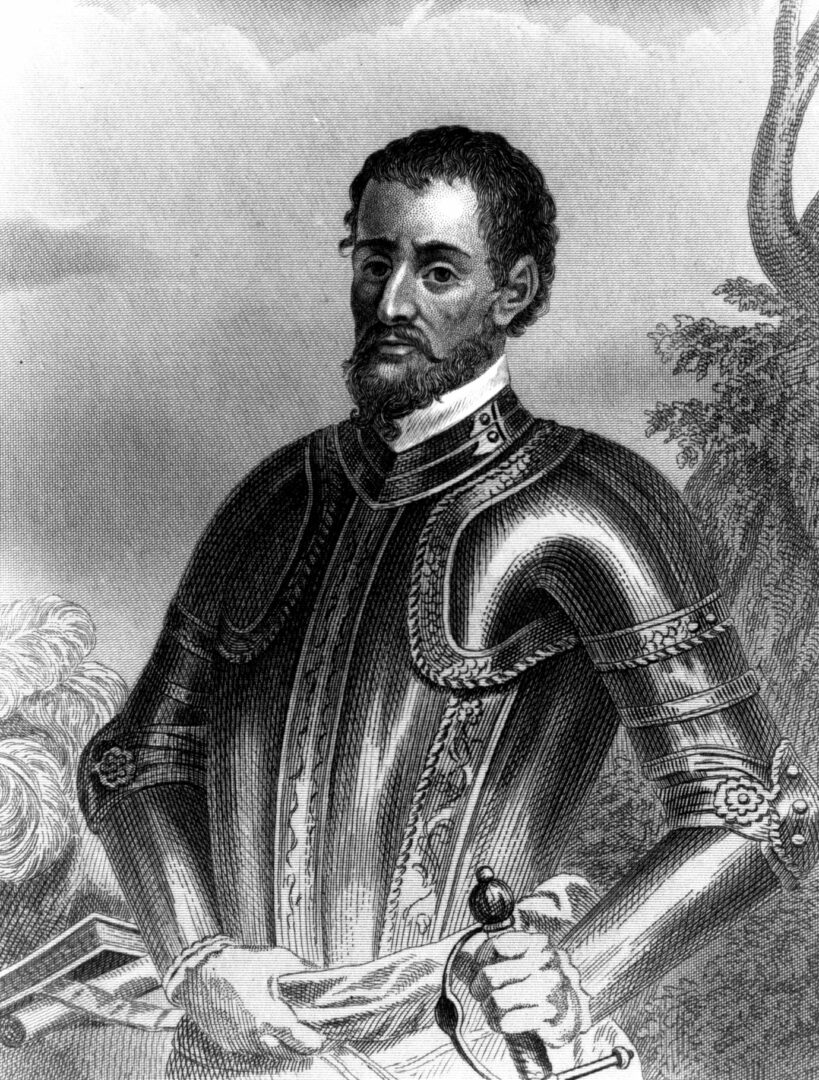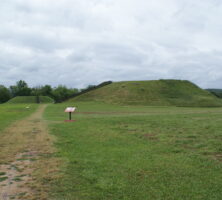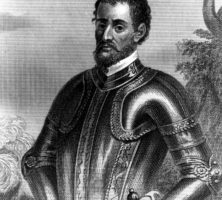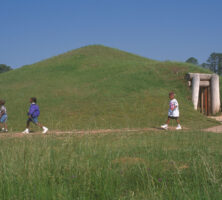The Nature of Chiefdoms
Prior to European exploration, the Indians of Georgia and other parts of the Southeast had achieved the highest level of political organization north of the Mesoamerican Aztec and Maya states. These southeastern political organizations are termed chiefdoms by anthropologists.

A chiefdom, ruled by a hereditary and often semi-divine chief, was typically a multiple town organization, with a population in the low thousands. The chief resided in a capital town, with other towns paying tribute to support him and his family, part-time craftspersons, and military expeditions. Chiefdoms typically built impressive monuments. In the Southeast, Native Americans constructed large earthen mounds as platforms for the homes of their chiefs and the temples to their gods. Chiefdoms rarely exceeded twenty-five miles in diameter and were surrounded by large empty spaces that served as hunting preserves as well as buffer zones from political rivals. The present state of Georgia was the home of several chiefdoms. Through eyewitness accounts of sixteenth-century Spanish explorers and the archaeological record, we now know a great deal about these groups.
Inhabitants of these Georgia chiefdoms had what archaeologists call a Mississippian lifestyle. The women were farmers, growing corn, beans, squash, sunflowers, and other plants. The men supplied meat by hunting and fishing, because there were no domesticated animals. They gathered other wild foods, such as herbs, nuts, and berries.
Warfare was another major occupation for men of the chiefdoms. Both early Spanish accounts and archaeology reveal the importance of warfare in the lives of these people. Spanish explorers fought battles against large armies of Native Americans in the Southeast. Archaeologists have uncovered complex fortifications around native towns and have found direct evidence of war wounds, including scalping marks, on excavated skeletons of Southeastern Indians. Prehistoric art from archaeological sites, such as Etowah in Georgia, frequently depicts war themes.
Chiefdom of Coosa
Coosa is one of the best-known chiefdoms in the area that is now Georgia. Located on the Coosawattee River in modern Gordon and Murray counties, Coosa (according to Spanish explorers) consisted of eight towns, of which archaeologists have located at least seven. The capital, an archaeological site known as Little Egypt, was excavated by archaeologist David Hally for the University of Georgia in the early 1970s. The Little Egypt site comprised three earthen mounds surrounding an open plaza area in the center of a large village. One other town had a single mound, while the other villages lacked mounds. The population of the Coosa chiefdom is estimated to have been 2,500 to 4,650 people.
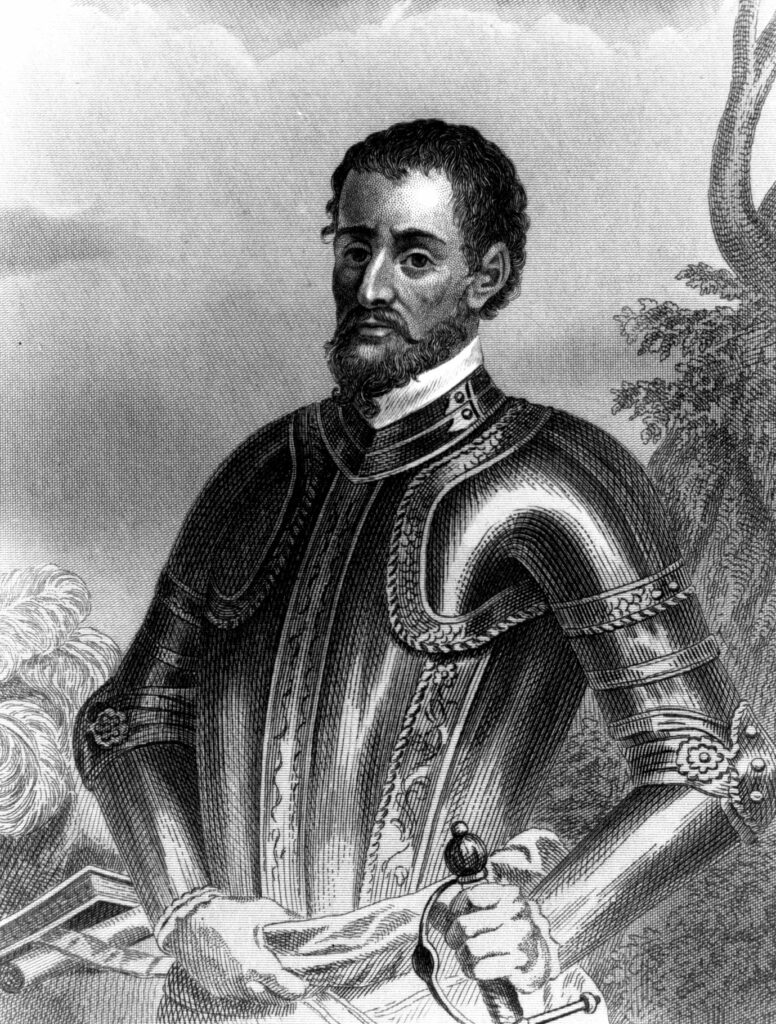
The chiefdom of Coosa was part of a larger political organization, the paramount chiefdom of Coosa; the Coosa chief ruled over other, similar chiefdoms, stretching from what is now upper eastern Tennessee to east-central Alabama. There were at least seven chiefdoms in this large organization, according to archaeological and historical sources. This paramount chiefdom extended along the western edge of the Appalachian Mountains for a distance of almost 400 miles and contained a population of up to 50,000 people. Chroniclers of the Hernando de Soto expedition of 1540 described Coosa in glowing terms. It is only from historical sources that we can reconstruct the paramount chiefdom of Coosa. From an archaeological perspective, this large organization incorporated several different linguistic and cultural groups.
The King site was perhaps a typical village within the paramount chiefdom of Coosa. This archaeological site, located on the Coosa River west of modern Rome, was excavated by David Hally of the University of Georgia and Patrick Garrow of Shorter College (later Shorter University). It was made up of approximately forty-seven houses surrounding an open courtyard, with a large public meetinghouse near the center of town. The village was heavily fortified with a wooden palisade wall and an encircling ditch. Estimates of the King site population range from 277 to 517 people.
Other Chiefdoms
Other chiefdoms were located on most of Georgia’s major river drainages and on the Atlantic coast. Another paramount chiefdom, named Ocute according to early Spanish sources, was located along the Oconee River from present Milledgeville almost to Athens. This polity consisted of six mound centers and many villages, hamlets, and farmsteads. Archaeologists from the LAMAR Institute, the University of Georgia, and Penn State University have tested all the mound centers and several of the smaller archaeological sites. This area is unusual in that many people lived in scattered farms in the uplands instead of being concentrated in the river valley, as in most other chiefdoms.
The chiefdom of Ichisi, also visited by Hernando de Soto, was located between modern Macon and Perry on the Ocmulgee River. The capital town was probably located at the present-day Lamar archaeological site, a part of Ocmulgee Mounds National Historical Park. Three, perhaps four, additional archaeological town sites that made up this chiefdom have been identified. The Southeastern Indian historian Charles Hudson suggests that the chiefdom of Ichisi may have been allied with the chiefdom of Ocute.

Other major chiefdoms mentioned in Spanish sources and known through archaeology include Toa on the Flint River, Capachequi near present Albany, Apalachicola near modern Columbus, and Guale located on the Georgia coast in an area centering on St. Catherines Island. The Guale chiefdom is known from early Spanish sources and was the scene of major missionary efforts in the late sixteenth and early seventeenth centuries. Archaeologists from the American Museum of Natural History have excavated the main mission complex on St. Catherines. Other late prehistoric chiefdoms, whose names were not recorded in historical sources, include polities centered on the Nacoochee Mound near Helen, Georgia, and the upper Savannah River area.
End of the Chiefdoms
Georgia’s chiefdoms collapsed very quickly following European exploration in the sixteenth century. Europeans brought in many new diseases to which Native Americans had no natural immunity; consequently, their populations plummeted. Because these reduced populations could no longer support a hereditary elite stratum of society, the chiefdom form of political organization was replaced by simpler forms. The arts declined, in part because craftspersons were no longer subsidized. Within a century European technology had already replaced aboriginal technology.
In areas of coastal and southern Georgia, Native American populations were incorporated into the expanding Spanish mission system. In other areas, disease led to population movements and amalgamation into ever-decreasing numbers of towns. The Coosa chiefdom, for example, collapsed into a few towns, which came to be located far down the Coosa River in present Alabama. By the end of the sixteenth century northwestern Georgia had been abandoned, but it was resettled by Cherokee Indians in the eighteenth century. The collapse of chiefdoms led to the formation of such familiar Native American societies as the Creek and the Cherokee.


